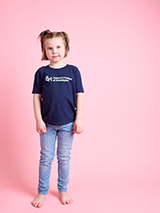Alexandria’s Story: Burr Hole Hemispherotomy for Seizures Caused By Perinatal Stroke
Alexandria was born at Pennsylvania Hospital, the nation’s first hospital, located in downtown Philadelphia. Everything seemed fine just after her C-section delivery, but within 24 hours of her birth, her mother, Kacy, noticed Alexandria’s eye twitching. She pointed it out to a nurse who brought in a neonatologist to evaluate the newborn. The neonatologist said the twitch was, in fact, a seizure.

Alexandria was taken to Pennsylvania Hospital’s neonatal intensive care unit (NICU), which is staffed by board-certified neonatologists from Children’s Hospital of Philadelphia (CHOP). Pediatric subspecialists from CHOP are also available for consultation in the NICU. An MRI showed Alexandria had experienced a stroke either in the womb or during the delivery.
Alexandria was given a feeding tube and oxygen support while she received anti-seizure medication. After 10 days in the NICU, she was discharged home in time for Christmas on anti-seizure medication. A month later, she was weaned off the medication.
She remained seizure-free for the next three years. During that time, she had regular follow-up appointments with Rebecca N. Ichord, MD, a specialist in childhood stroke with CHOP’s Neuroscience Center. Alexandria also had physical therapy (PT), occupational therapy (OT) and speech therapy appointments to work through some hand weakness and speech delays the stroke had caused.
Stroke-related seizures start
On March 13, 2020, Alexandria experienced a grand mal seizure. It was the first of eight grand mal seizures she had that year. The seizures were horrific, lasting 45 minutes to an hour.
Dr. Ichord put Alexandria back on one anti-seizure medication; then she tried increasing the medication dose; then she added another medication. But nothing provided lasting seizure control.
“They were awful,” recalls Kacy. “It was a pretty hard time for our family to say the least. Being on two medications and having seizures really took a toll on everything. You never knew when the next one would hit. It was like waiting for a bomb to go off.”
CHOP’s Neuroscience Center consists of a large interdisciplinary team of pediatric neurologists, neurosurgeons, pediatric epileptologists, fellows and residents, among others, who meet regularly to determine the best path forward for each patient. Dr. Ichord, Pediatric Epileptologist France W. Fung, MD, and Attending Neurosurgeon and Director of Epilepsy and Functional Neurosurgery, Benjamin Kennedy, MD, thought Alexandria might be a good candidate for a functional hemispherotomy.
Functional hemispherotomy is a surgical treatment option the CHOP team considers when a child’s seizures don’t respond to medication. It is most successful for seizures that only originate from one side of the brain. In the procedure, the side of the brain that is causing seizures is disconnected from the healthy side of the brain and the brainstem.
Evaluation for hemispherotomy surgery
Alexandria was admitted to CHOP and underwent a continuous electroencephalogram (EEG) to determine if a functional hemispherotomy was a good option for her. At the end of her 14-day stay, Drs. Ichord, Fung and Kennedy met with Kacy and her husband, Chris, to discuss the results of the EEG. The study had determined that all of Alexandria’s seizures originated in the left hemisphere of her brain, which meant she was a good candidate for the procedure.
Dr. Kennedy explained the risks and benefits of the procedure to Kacy and Chris. Performing a hemispherotomy early on in a child’s life helps maintain normal development. There is a window of opportunity for brain development, and the older a child gets, the less adaptable the brain becomes. As a result, earlier epilepsy surgery results in not only better seizure outcomes, but better cognitive and developmental outcomes as well.
The left hemisphere of the brain controls movement on the right side of the body, so Dr. Kennedy expected that Alexandria might experience right-sided weakness after surgery. But he expected that with diligent physical and occupational therapy, function on the right side would gradually improve.
“Dr. Kennedy is really amazing and made us feel really at ease,” says Kacy. “For her quality of life going forward, the earlier she had the surgery the better. The clock was theoretically ticking.”
Zero seizures since surgery

When she was 4 years old, Alexandria underwent a hemispherotomy through a burr hole the size of a quarter. She hasn’t had a seizure since. Her incision being only an inch and a half long aided a rapid recovery. After surgery, she spent a month in CHOP’s Seashore House, an inpatient rehabilitation unit, to regain some function in her right hand. After a lot of physical and occupational therapy, her right-hand function is now even better than before.
She has now been weaned off all anti-seizure medications, and her physicians are hopeful that she will never experience another seizure.
“She’s thriving,” says Kacy. Alexandria goes to kindergarten, takes a dance class, and loves playing on the playground. Her personality is in full bloom.
“It’s really amazing. We would have never guessed this in 2020, in the midst of her having seizures, that she’d be off her meds and a normal, happy 6-year-old. She’s the most social kid that I’ve ever seen. She has the best personality and is so full of life. She’s a joy to be around.”